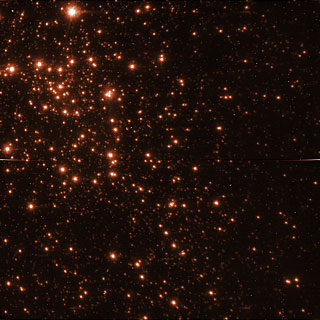NACO
Nasmyth Adaptive Optics System (NAOS) – Near-Infrared Imager and Spectrograph (CONICA)
Twinkling stars. An intriguing effect to admire during the night, commonly seen everywhere in the sky, but often more noticeable near the horizon. A beautiful effect with a simple explanation — small changes in the Earth's atmosphere distort the light waves from any astronomical object before they can reach our eyes — or an Earth-bound telescope!
So for astronomers, this phenomenon is a real nightmare, literally blurring out hours of observation over an entire night. And it’s not so simple to avoid — astronomers have to resort to a sophisticated technique called Adaptive Optics to compensate for this effect.
The Paranal Observatory’s NAOS+CONICA instrument, better known as NACO, is one of the best ground-based solutions to atmospheric turbulence. Thanks to its pioneering use of Adaptive Optics, NACO delivers images as sharp as if we were in space.
This instrument has two systems working together. First there is NAOS, or the Nasmyth Adaptive Optics System: an adaptive optics system equipped with visible and infrared sensors, which, thanks to a flexible mirror controlled by computer, counteracts the image distortion caused by atmospheric turbulence in real time.
The second part is CONICA, which is the infrared camera and spectrometer attached to NAOS. Together, they form the first adaptive optics system to have been installed on the Very Large Telescope (VLT).
NACO has been contributing to major discoveries in different fields of astronomy since 2001: exoplanets, the Galactic centre of the Milky Way, young stellar objects, Solar System bodies, etc.
NACO has observed planets orbiting other stars, providing the first-ever direct image of an exoplanet in 2004. By 2010, it had been able to directly follow the motion of an exoplanet as it moved from one side of the star Beta Pictoris to the other (eso1024). The instrument has also provided the first-ever spectrum of a directly observed exoplanet, allowing astronomers to study the planet’s atmosphere (eso1002).
Moreover, NACO was involved in one of the most important recent long-term astronomical research programmes. In a 16-year-long study, and after observing 28 stars, astronomers produced the most detailed view ever of the motions of the stars at the heart of our galaxy, the Milky Way — and providing evidence for the existence of a lurking supermassive black hole there.
During 2013 alone, 57 papers were produced by the scientific community with data obtained by NACO. NACO has now been moved from Unit Telescope 4 to Unit Telescope 1.
Science highlights with NACO
- Least massive planet to be directly observed outside the Solar System (eso1324)
- MUSE obtains what is likely the first direct observation of a forming planet still embedded in a thick disc of gas and dust (eso1310)
- Discovery that planets around stars are the rule rather than the exception (eso1204)
- Gas cloud with several times the mass of the Earth spotted accelerating fast towards the black hole at the centre of the Milky Way (eso1151)
- Possible first object clearing its path in the natal disc surrounding a young star (eso1106)
- Exoplanet caught on the move (eso1024)
- NACO tracks stars orbiting the supermassive black hole at the centre of the Milky Way (eso0846)
- NACO observes Titan's atmosphere and surface (eso0505)
- NACO observes an intriguing object near a young brown dwarf: the first direct image of an exoplanet (eso0428)
- Fine images of Saturn and Io with VLT NACO (eso0204)
|
A raw image straight from NACO. This snapshot was obtained through the near-infrared K filter and, together with many other images, was used to create the iconic view of the centre of the Milky Way, reproduced further up this page. Many bright pixels pepper this single image; these are the hot pixels, which are typical of an infrared detector. They disappear several images obtained at slightly different positions are combined. |
NACOThe authoritative technical specifications as offered for astronomical observations are available from the Science Operation page.
|



